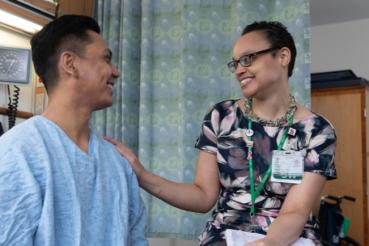Rush University Medical Center will invest more than $6 million over the next three years in organizations that are working to revitalize neighborhoods on the West Side of Chicago. The investments are part of Rush’s broader endeavor to be an anchor of better health for residents of Chicago’s West Side by improving the economic health of their neighborhoods.
“Rush's mission of improving the health of the individuals and communities we serve is about more than just providing quality health care,” said Dr. Larry Goodman, CEO of the Rush system and Rush University Medical Center. “We must also address the social and economic forces that are root causes of poor health, and increasing the amount of affordable housing and jobs in West Side communities does just that.”
Rush will make its investments by partnering with Community Development Financial Institutions. These CDFIs, as they’re known, are private financial institutions that help community development organizations and small businesses in underserved communities gain access to capital often unavailable by traditional lenders.
'These are investments, not donations or grants'
The first of Rush’s “social impact investments” — loans that provide both an economic and social return — is a $1.08 million loan to the CDFI Chicago Community Loan Fund. Rush’s loan is part of a larger $6 million investment as part of the city of Chicago’s Neighborhood Rebuild Training pilot program, which will be used to convert 50 vacant buildings in distressed Chicago neighborhoods into single family or two-flat homes over the next three years.
Local contractors will hire and train about 200 ex-offenders and at-risk Chicago youths to help rehabilitate the homes, which then will be sold at affordable rates. The city of Chicago and Rush announced the investments on Sept. 13.
In August, Rush also invested $1 million in IFF, the largest nonprofit CDFI in the Midwest, to fund a series of projects that will also address socioeconomic challenges linked with poor health.
“These are investments, not donations or grants,” says Patricia Steeves O’Neil, chief investment officer and treasurer at Rush University Medical Center. “We fully expect to get our funds back with a small return in the short term, but also expect to see the health benefits of more job opportunities and better housing in the long term.” Rush plans to make additional $2 million impact investments in both 2018 and in 2019.
Better housing equals better health
Increasing affordable, high-quality housing can improve community health in several ways, according to Tricia Johnson, PhD, associate chairperson and professor, Department of Health Systems Management in the College of Health Sciences at Rush University. “Better housing greatly reduces mental stress and thus the conditions exacerbated by stress,” Johnson said. “Affordable housing frees up money for other necessary items, such as food and medicine, and improved housing also reduces illnesses from lead poisoning, asthma, accidents and the infectious diseases driven by crowded housing.”
Social impact investing is a just one tenet of Rush’ broader anchor effort, which aims to produce economic benefits from how Rush hires, purchases and invests in West Side neighborhoods. Research has shown that the structural determinants and conditions in which people are born, grow, live, work and age — such as education, employment, their physical environment and access to health care — affect longevity or life span. When poverty is concentrated in neighborhoods, life span is stunted.
Rush is one of about 30 health systems nationwide to adopt the “anchor mission” philosophy of using the organization’s clinical and non-clinical assets to address these social determinants of health.
Rush detailed its plans to address the top health need of the communities it serves in the 2016-2019 Community Health Implementation Plan, filed with the federal government in November 2016. The top goal of that plan is “Reducing inequities caused by the social, economic and structural determinants of health.”
Home to about 420,000 individuals, the West Side neighborhoods included in Rush’s Community Health Implementation Plan include the lower West Side, West Town, East Garfield Park, West Garfield Park, North Lawndale, South Lawndale, the near West Side and Austin.
“Rush’s anchor initiative brings together Rush’s community engagement and population health efforts,” said Darlene Hightower, associate vice president, community engagement and practice. “By rethinking some of our business practices — especially hiring, investing and buying locally — we can better use our resources to drive economic development and attack deeply rooted community problems that shorten life expectancy.”




